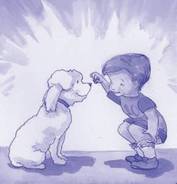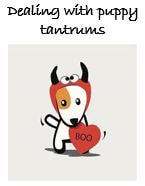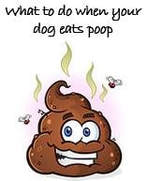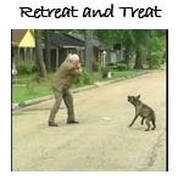COME-SIT-DOWN-STAY
Dr Ian Dunbar
courtesy www.dogstardaily.com

© 2004 Ian Dunbar
Leashless-training methods are essential for pet dogs, because they are usually off-leash indoors. Lure-reward and reward-training techniques make training quick, easy, effective, and enjoyable for dogs and their owners. Reward training is as owner-friendly as it is dog-friendly. Since reward- training depend on brain rather than brawn, the techniques are easily mastered by all dog owners, including children.
Weigh out the puppy or dog's daily allotment of kibble and put it in a container for family members to use for all of these exercises. Every piece counts as an individual lure and reward. Use kibble to train throughout the course of the day.
Come
For puppies, simply say "Puppy, Come," do something silly, and your puppy will come running. Praise your pup as she comes running towards you, and grab her collar and offer a food reward when she arrives. For adult dogs, say "Doggy, Come" and then squat down a waggle a food lure in front of you. Two or more family members may practice yo-yo (back and forth) or round- robin recalls. Say "Puppy, go to Jamie" as a cue for Jamie to call the pup. Once Jamie has hold of the puppy's collar, it is his turn to choose who to send the puppy to. This is a great way to teach your puppy "Go to…" commands, as well as the names of family members.
Sit
Hold a food treat in front of your dog's nose, say "Sit," and move the lure upwards and backwards just above the dog's muzzle. As your dog looks up to follow the treat, she will sit down. If your dog jumps up, you are holding the treat too high. If your dog backs up, work with the dog in a corner. When she sits, say "Good girl!" (or "Good boy!" if you have a boy-pup), and offer the kibble as a reward. From now on, ask your dog to sit in front of you after every recall.
Down
Say "Down," and quickly lower the treat from the dog's nose to a point in between the dog's forepaws. Praise the dog when she lies down ("Goood girl!") and offer the treat. It is easier to entice your dog to lie down if she is already sitting, since her hindquarters are already down.
To teach your dog to lie down when she is standing, hold the lure between finger and thumb and lower the hand (palm downwards) to rest on the floor. As the dog worries at the lure, she will likely place the side of her muzzle on the floor ("Good girl!") and then assume a play-bow with elbows and sternum on the ground ("Gooood girl!"). By gently moving the lure towards the dog's chest and between her forepaws, her rear end will collapse backwards and she will lie down ("GOOOD GIRL!!!") Now step back and ask your puppy to come, sit, and lie down. An upward motion of your hand (held palm-upwards) has become the
Stay
Handsignal to sit, and a downward motion of your hand (held palm-downwards) has become the handsignal to lie down.
Stand
Stand is a very useful command when you want (or your veterinarian wants) to examine your dog. Say "Stand" and move the lure away from the dog's nose, waggling it in the position where your dog's nose will be when she stands. When she stands, say "Good girl" and offer the lure as a reward. Repeat sequences of the three body positions (sit, down, and stand) in random order, e.g., sit-down-sit-stand-down-stand. Initially, praise and reward each correct response. Once your dog responds fairly reliably, only reward her quicker and snazzier responses. Have family competitions to see how many body position changes your dog will do for just one food reward.
Initially, praise and reward your dog the instant she sits, lies down, or stands. With successive trials however, continue to praise correct responses but progressively delay offering the food reward for a little longer each time: for two seconds, then three seconds, five, eight, twelve, twenty, forty, sixty, and so on. Before you know it, your dog will happily respond quickly and remain in place for several minutes.
Phasing Out Food Lures and Rewards
Initially, use kibble both as lures to entice your dog to come, sit, lie down, and stand, and as rewards for doing so. Thereafter, use different items as lures and rewards. For example, lure the dog with a Kong but reward it by throwing a tennis ball. Or, lure the dog with a kibble but say "Go play!" as a reward. After a few repetitions dispense with food lures entirely—your verbal instructions and handsignals will suffice; from now on only use kibble as a reward.
Finally, dispense with training treats as rewards. Instead, ask your dog to sit and/or lie down before every enjoyable doggy activity. Have your dog sit, lie down, or stand-stay before scratching her ear, before throwing her ball, before letting her off-leash, and before inviting her to share the couch: i.e., replace food rewards with more meaningful life-rewards.
Now you will be able to ask your dog to sit for her supper in a bowl because you no longer need to use her kibble as training lures and rewards.
To learn more about lure-reward training, read Doctor Dunbar's Good Little Dog Book and watch Training Dogs With Dunbar, both available from your local pet store or on-line at www.amazon.com. Reprinted by www.dogstardaily.com with permission of Dr. Ian Dunbar and James & Kenneth Publishers behavior blueprint by Dr. Ian Dunbar 2004©
BEHAVIOR BLUEPRINTS from www.jamesandkenneth.com New Puppy, New Adult Dog, Housetraining, Chewing, Digging, Barking, Home Alone, Puppy Biting, Fighting, Fear of People, Dogs & Children, HyperDog, Puppy Training, Come-Sit-Down-Stay, Walking On Leash, and Cat Manners.
Weigh out the puppy or dog's daily allotment of kibble and put it in a container for family members to use for all of these exercises. Every piece counts as an individual lure and reward. Use kibble to train throughout the course of the day.
Come
For puppies, simply say "Puppy, Come," do something silly, and your puppy will come running. Praise your pup as she comes running towards you, and grab her collar and offer a food reward when she arrives. For adult dogs, say "Doggy, Come" and then squat down a waggle a food lure in front of you. Two or more family members may practice yo-yo (back and forth) or round- robin recalls. Say "Puppy, go to Jamie" as a cue for Jamie to call the pup. Once Jamie has hold of the puppy's collar, it is his turn to choose who to send the puppy to. This is a great way to teach your puppy "Go to…" commands, as well as the names of family members.
Sit
Hold a food treat in front of your dog's nose, say "Sit," and move the lure upwards and backwards just above the dog's muzzle. As your dog looks up to follow the treat, she will sit down. If your dog jumps up, you are holding the treat too high. If your dog backs up, work with the dog in a corner. When she sits, say "Good girl!" (or "Good boy!" if you have a boy-pup), and offer the kibble as a reward. From now on, ask your dog to sit in front of you after every recall.
Down
Say "Down," and quickly lower the treat from the dog's nose to a point in between the dog's forepaws. Praise the dog when she lies down ("Goood girl!") and offer the treat. It is easier to entice your dog to lie down if she is already sitting, since her hindquarters are already down.
To teach your dog to lie down when she is standing, hold the lure between finger and thumb and lower the hand (palm downwards) to rest on the floor. As the dog worries at the lure, she will likely place the side of her muzzle on the floor ("Good girl!") and then assume a play-bow with elbows and sternum on the ground ("Gooood girl!"). By gently moving the lure towards the dog's chest and between her forepaws, her rear end will collapse backwards and she will lie down ("GOOOD GIRL!!!") Now step back and ask your puppy to come, sit, and lie down. An upward motion of your hand (held palm-upwards) has become the
Stay
Handsignal to sit, and a downward motion of your hand (held palm-downwards) has become the handsignal to lie down.
Stand
Stand is a very useful command when you want (or your veterinarian wants) to examine your dog. Say "Stand" and move the lure away from the dog's nose, waggling it in the position where your dog's nose will be when she stands. When she stands, say "Good girl" and offer the lure as a reward. Repeat sequences of the three body positions (sit, down, and stand) in random order, e.g., sit-down-sit-stand-down-stand. Initially, praise and reward each correct response. Once your dog responds fairly reliably, only reward her quicker and snazzier responses. Have family competitions to see how many body position changes your dog will do for just one food reward.
Initially, praise and reward your dog the instant she sits, lies down, or stands. With successive trials however, continue to praise correct responses but progressively delay offering the food reward for a little longer each time: for two seconds, then three seconds, five, eight, twelve, twenty, forty, sixty, and so on. Before you know it, your dog will happily respond quickly and remain in place for several minutes.
Phasing Out Food Lures and Rewards
Initially, use kibble both as lures to entice your dog to come, sit, lie down, and stand, and as rewards for doing so. Thereafter, use different items as lures and rewards. For example, lure the dog with a Kong but reward it by throwing a tennis ball. Or, lure the dog with a kibble but say "Go play!" as a reward. After a few repetitions dispense with food lures entirely—your verbal instructions and handsignals will suffice; from now on only use kibble as a reward.
Finally, dispense with training treats as rewards. Instead, ask your dog to sit and/or lie down before every enjoyable doggy activity. Have your dog sit, lie down, or stand-stay before scratching her ear, before throwing her ball, before letting her off-leash, and before inviting her to share the couch: i.e., replace food rewards with more meaningful life-rewards.
Now you will be able to ask your dog to sit for her supper in a bowl because you no longer need to use her kibble as training lures and rewards.
To learn more about lure-reward training, read Doctor Dunbar's Good Little Dog Book and watch Training Dogs With Dunbar, both available from your local pet store or on-line at www.amazon.com. Reprinted by www.dogstardaily.com with permission of Dr. Ian Dunbar and James & Kenneth Publishers behavior blueprint by Dr. Ian Dunbar 2004©
BEHAVIOR BLUEPRINTS from www.jamesandkenneth.com New Puppy, New Adult Dog, Housetraining, Chewing, Digging, Barking, Home Alone, Puppy Biting, Fighting, Fear of People, Dogs & Children, HyperDog, Puppy Training, Come-Sit-Down-Stay, Walking On Leash, and Cat Manners.
|
Dealing with puppy tantrums.
This may initially look cute when Fluffy is 10 weeks old, however the beginning of what can be a dangerous practice! Here is how to change the behaviour. |
What to do when your dog eats poop.
As digusting as this is to us humans, to dogs it is a natural behaviour! Here is why it happens and what to do to stop it. |
Retreat and Treat
Being confronted by a dog off lead, exhibiting aggressive is scary. Knowing about Retreat and Treat can be of enormous value |




